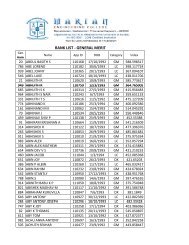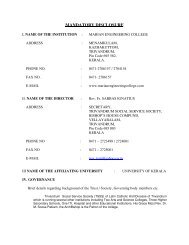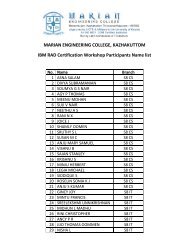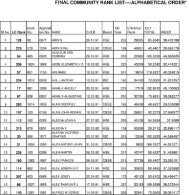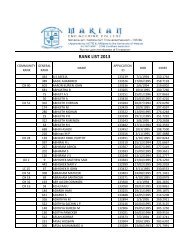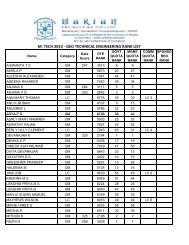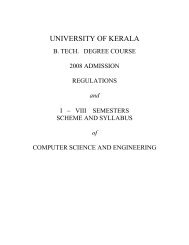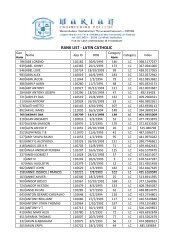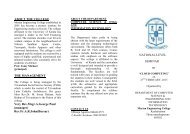UNIVERSITY OF KERALA - College of Engineering, Trivandrum
UNIVERSITY OF KERALA - College of Engineering, Trivandrum
UNIVERSITY OF KERALA - College of Engineering, Trivandrum
Create successful ePaper yourself
Turn your PDF publications into a flip-book with our unique Google optimized e-Paper software.
08.602 GEOTECHNICAL ENGINEERING-I<br />
L T P/D Cr<br />
3 1 0 4<br />
Module I<br />
Soil formation - Major soil deposits <strong>of</strong> India - Basic soil properties - Weight-volume relationships - Void ratio,<br />
porosity, degree <strong>of</strong> saturation, air content, percentage air voids, moisture content, specific gravity, bulk,<br />
saturated and submerged unit weights - Relationship between basic soil properties<br />
Index properties - Sieve analysis – Well graded, poorly graded and gap graded soils - Stoke’s law - Hydrometer<br />
analysis – Relative density – Consistency - Atterberg Limits - Practical Applications - Field identification <strong>of</strong><br />
soils - I.S. classification <strong>of</strong> soils<br />
Compaction <strong>of</strong> soils - Standard Proctor, Modified Proctor, I.S. light & Heavy Compaction Tests – OMC - Zero<br />
Air voids line - Control <strong>of</strong> compaction - Field methods <strong>of</strong> compaction[Brief discussion only].<br />
Module II<br />
Permeability <strong>of</strong> soils - Darcy’s law – Factors affecting permeability - Constant head and falling head<br />
permeability tests - Average permeability <strong>of</strong> stratified deposits<br />
Principle <strong>of</strong> effective stress - Total , neutral and effective stress variation diagrams - Quick sand condition -<br />
Critical hydraulic gradient - Estimation <strong>of</strong> quantity <strong>of</strong> seepage using flow nets[only for the case <strong>of</strong> seepage<br />
around a single row <strong>of</strong> sheet piles] – Definition <strong>of</strong> phreatic line and exit gradient.<br />
Compressibility and Consolidation - Void ratio versus pressure relationship - Coefficient <strong>of</strong> compressibility and<br />
volume compressibility – Compression index - Change in void ratio method - Height <strong>of</strong> solids method -<br />
Normally consolidated, under consolidated and over consolidated states - Estimation <strong>of</strong> pre consolidation<br />
pressure - Estimation <strong>of</strong> magnitude <strong>of</strong> settlement <strong>of</strong> normally consolidated clays – Terzaghi’s theory <strong>of</strong> onedimensional<br />
consolidation(no derivation required) - average degree <strong>of</strong> consolidation – Time factor - Coefficient<br />
<strong>of</strong> consolidation - Square root <strong>of</strong> time & logarithm <strong>of</strong> time fitting methods-<br />
Module III<br />
Shear strength <strong>of</strong> soils - Mohr’s circle - Mohr-Coulomb failure criterion - Direct shear test, triaxial compression<br />
test, vane shear test, unconfined compression test - Merits and drawbacks <strong>of</strong> the tests - UU and CD tests[Brief<br />
discussion only] - Sensitivity - Thixotropy - Liquefaction - Critical void ratio<br />
Stability <strong>of</strong> finite slopes - Toe failure, base failure, slip failure - Swedish Circle Method – Friction circle method<br />
– Factor <strong>of</strong> safety with respect to cohesion and angle <strong>of</strong> internal friction - Stability number - Stability charts -<br />
Methods to improve slope stability<br />
References:<br />
1. Gopal Ranjan & A.S.R Rao --- Basic and Applied Soil Mechanics – New Age International (P) Limited, New<br />
Delhi, 2002<br />
2. K.R. Arora --- Geotechnical <strong>Engineering</strong> – Standard Publishers Distributors, New Delhi, 2006<br />
3. Venkatramaiah --- Geotechnical <strong>Engineering</strong> – Universities Press (India) Limited, Hyderabad, 2000<br />
4. Terzaghi and Peck --- Soil Mechanics in <strong>Engineering</strong> Practice – John Wiley & Sons, New York, 1967<br />
5. D.W.Taylor --- Fundamentals <strong>of</strong> Soil Mechanics – Asia Publishing House, New Delhi, 1948<br />
6.P.Purushothamaraj --- Soil Mechanics and Foundation <strong>Engineering</strong> – Pearson Education, Delhi, 2008<br />
Question Paper:<br />
Duration: 3 hours<br />
The question paper consists <strong>of</strong> Part A and Part B.<br />
Part A carries 40 marks. There will be 8 compulsory short answer questions covering entire syllabus.<br />
Part B is for 60 marks. There will be 2 questions from each module. The candidate has to answer one question<br />
<strong>of</strong> 20 marks from each module.<br />
Note: No other charts, tables, codes are permitted in the Examination hall .If necessary relevant data shall be<br />
given along with the question paper by the question paper setter<br />
55



